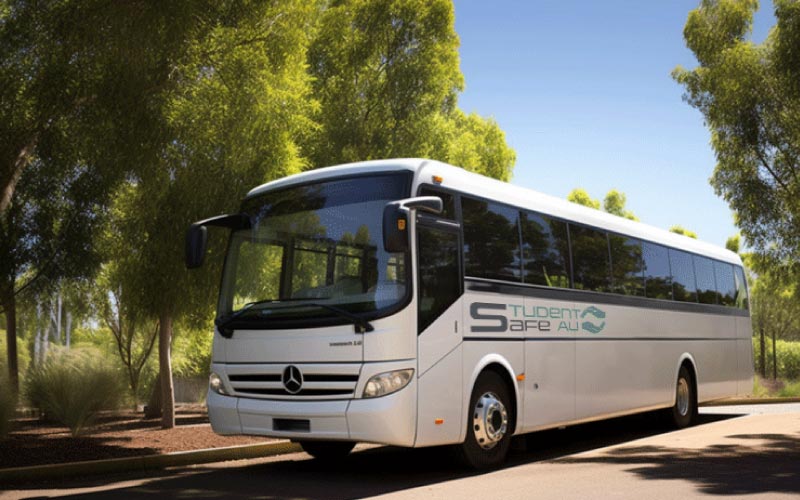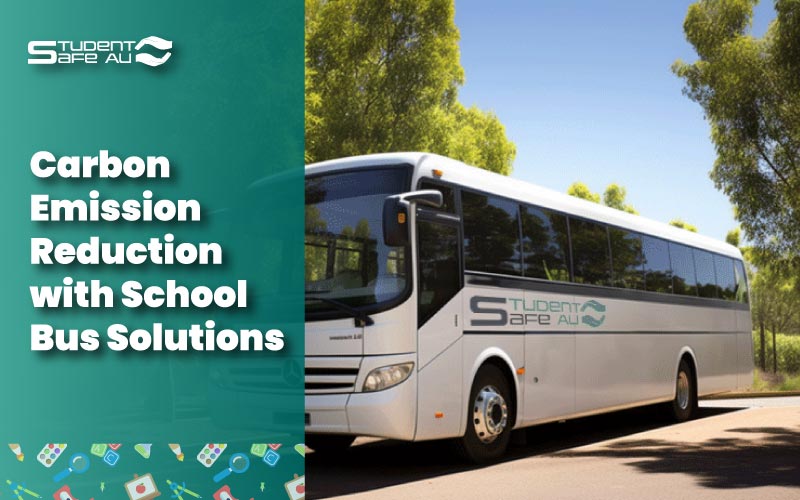Learn how StudentSafe AU’s school bus initiative is helping reduce carbon emissions and create sustainable transport options in Australia.
At StudentSafe AU, we are committed to leading the charge in sustainable transport by actively reducing carbon emissions and promoting environmentally friendly transportation solutions. In this case study, we showcase how our innovative school bus services have significantly lowered CO2 emissions, reduced operational costs, and delivered long-term social and economic benefits while supporting Australia’s efforts to combat climate change. Sustainable school transport bus solutions.
The Project: A Sustainable Partnership
In this case, we partnered with a private grammar school in Melbourne to create a more sustainable approach to student transport. The school had a history of parents driving their children to and from school in individual cars. We worked with them to introduce a school bus service, replacing many individual car journeys with five 16-seater minibuses.
This transition not only helped minimise the environmental impact of daily school commutes but also showcased the many advantages of adopting green transportation solutions.
The Solution: Implementing School Bus Services
We launched five daily bus services to transport students to and from school efficiently. By coordinating these routes, we ensured students could enjoy a smooth and stress-free daily journey. This project also demonstrated the measurable impact of sustainable transport in reducing emissions, lowering costs, and improving overall student well-being. Sustainable school transportation bus solutions.
The Environmental Impact: A Significant CO2 Reduction
To highlight the success of this initiative, we conducted a detailed analysis comparing the CO2 emissions of the previous car-based commutes with the new school bus system. Using data from the Australian Government’s National Greenhouse Accounts, we calculated the emissions of both modes of transport:
- Standard Petrol Car: 180 grams of CO2 per kilometre
- Standard 16-seater Minibus: 300 grams of CO2 per kilometre
Daily Emissions Comparison
Before the school adopted the bus system, the total daily distance covered by individual cars was approximately 464 km. The new bus routes reduced this to just 132 km per day. Here’s how the emissions compare:
- Individual Cars:
464 km x 180 grams CO2/km = 83,520 grams of CO2 per day - 5 Minibuses:
132 km x 300 grams CO2/km = 39,600 grams of CO2 per day
Daily CO2 Emission Savings:
83,520 grams – 39,600 grams = 43,920 grams of CO2 saved per day
Annual Emission Savings
With an average of 190 school days per year, the school bus service led to an annual CO2 emission savings of approximately 8,345 kg. From this perspective, the average tree absorbs about 22 kg of CO2 annually. So, by switching to the school bus service, the school effectively saves the equivalent of planting 379 trees every year!

Additional Benefits of the School Bus Service
Beyond the environmental impact, the school bus service has provided several additional benefits for the school, parents, and students.
1. Reduced Traffic Congestion
The school has significantly reduced campus traffic congestion by replacing individual car journeys with just five minibuses. This improves traffic flow during busy drop-off and pick-up times, making the surrounding areas safer and less stressful for everyone.
2. Lower Parking Demand
The need for parking spaces around the school has been dramatically reduced. Fewer cars mean less pressure on limited parking facilities, benefiting the school and nearby residents.
3. Improved Student Well-being
Students now enjoy a more relaxed and comfortable commute. A structured and reliable school bus service makes their mornings less stressful, setting a positive tone for the day ahead. The consistent schedule also allows for a smoother routine for students and parents.
4. Lower Vehicle Wear & Tear
With fewer individual car journeys, parents have noticed significant savings in vehicle maintenance, fuel costs, and depreciation. Families are also reducing vehicle wear and tear by opting for the school bus.
Conclusion: A Win for the Environment and the Community
This case study highlights the many advantages of transitioning to a sustainable school bus service. Not only did the switch cut CO2 emissions by a significant margin, but it also eased traffic congestion, lowered parking demand, and improved student well-being. Bus Hire for Education.
At StudentSafe AU, we’re proud to support schools and businesses in their efforts to reduce their carbon footprint. Through initiatives like this, we’re making a real difference in promoting green transportation solutions that benefit both the environment and the community. By working together, we can help Australia meet its climate goals and create a more sustainable future for everyone. Sustainable school bus solutions.
Let’s keep driving change, one bus route at a time!
